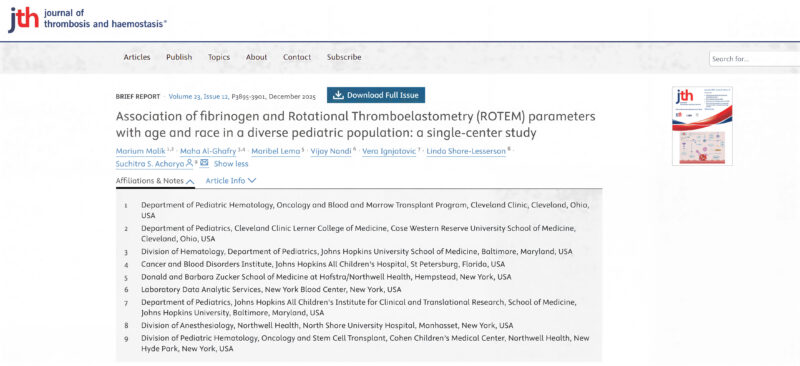
Why Pediatric ROTEM Needs Race-Specific Reference Ranges?
Vera Ignjatovic, Founder and Managing Director of Ignis Innovations Pty Ltd, shared a post by Journal of Thrombosis and Haemostasis (JTH) on LinkedIn:
”Here is the link to our paper describing the age and race-specific association of fibrinogen and Rotational Thromboelastometry (ROTEM) parameters in a diverse pediatric population.
Inclusion of a diverse population in establishing race-specific pediatric RIs has clinical and public health relevance for a more accurate diagnosis and personalized treatment.
Thank you, Marium Malik, Maha Al-Ghafry, Maribel Lema, Vijay Nandi, Linda Shore-Lesserson, and Suchitra S. Acharya for making this study possible. I am privileged to have worked with you in the late stages of this study.”
Quoting Journal of Thrombosis and Haemostasis (JTH)’s post:
”Association of fibrinogen and ROTEM parameters with age and race in a diverse pediatric population: a single-center study
By Marium Malik, Maha Al-Ghafry, Maribel Lema, Vijay Nandi, Vera Ignjatović, Linda Shore-Lesserson, and Suchitra S. Acharya
• Pediatric reference ranges for Rotational Thromboelastometry (ROTEM) – a whole-blood coagulation assay – are limited and rarely account for racial diversity.
• In 105 racially diverse children (1–21 years), investigators analyzed how age and race affect fibrinogen and ROTEM variables (EXTEM, INTEM, and FIBTEM).
• Fibrinogen and FIBTEM clot strength increased with age. Among Black/African American participants, rising age correlated with shorter clot times and stronger clot firmness, suggesting a prothrombotic hemostatic profile. This underscores the need for race-specific pediatric reference intervals for personalized coagulation assessment.
Read the article here.”
Title: Association of fibrinogen and Rotational Thromboelastometry (ROTEM) parameters with age and race in a diverse pediatric population: a single-center study
Authors: Marium Malik, Maha Al-Ghafry, Maribel Lema, Vijay Nandi, Vera Ignjatovic, Linda Shore-Lesserson, Suchitra S. Acharya

Stay updated with Hemostasis Today.
-
Nov 24, 2025, 10:25Jean Jacques Kiladjian Visits INSERM-supervised CIC 1408 Investigation Center
-
Nov 24, 2025, 10:06Amirpasha Moetazedian Invites a PHD Student to His Lab to Explore Sustainable Artificial Blood Vessels
-
Nov 24, 2025, 09:41Kamran Hajiyev Reflects on A Week of Innovation, Collaboration, and Scientific Exchange at SVIN 2025
-
Nov 24, 2025, 02:55Do You Know Why Clot Contracts? Marin Pavlov Reflects on Expert PE Conference 2025
-
Nov 24, 2025, 01:39Ashkan Shoamanesh Shares OCEANIC-STROKE Trial’s Successful Endpoints
-
Nov 24, 2025, 01:10Swarsat K Nath on HemeNext 2025: AI is Real, Measurable, and Already Changing Lives
-
Nov 23, 2025, 15:15Dirk Sibbing on OCEANIC-STROKE Demonstrationg Superiority of Asundexian vs. Placebo
-
Nov 23, 2025, 14:57Jesse Landry on SeraGene Therapeutics: Rewriting the Rules of Blood and Bleeding Disorders
-
Nov 23, 2025, 14:49Reza Shojaei: What Truly Motivates Donors And What Keeps Them Coming Back?
